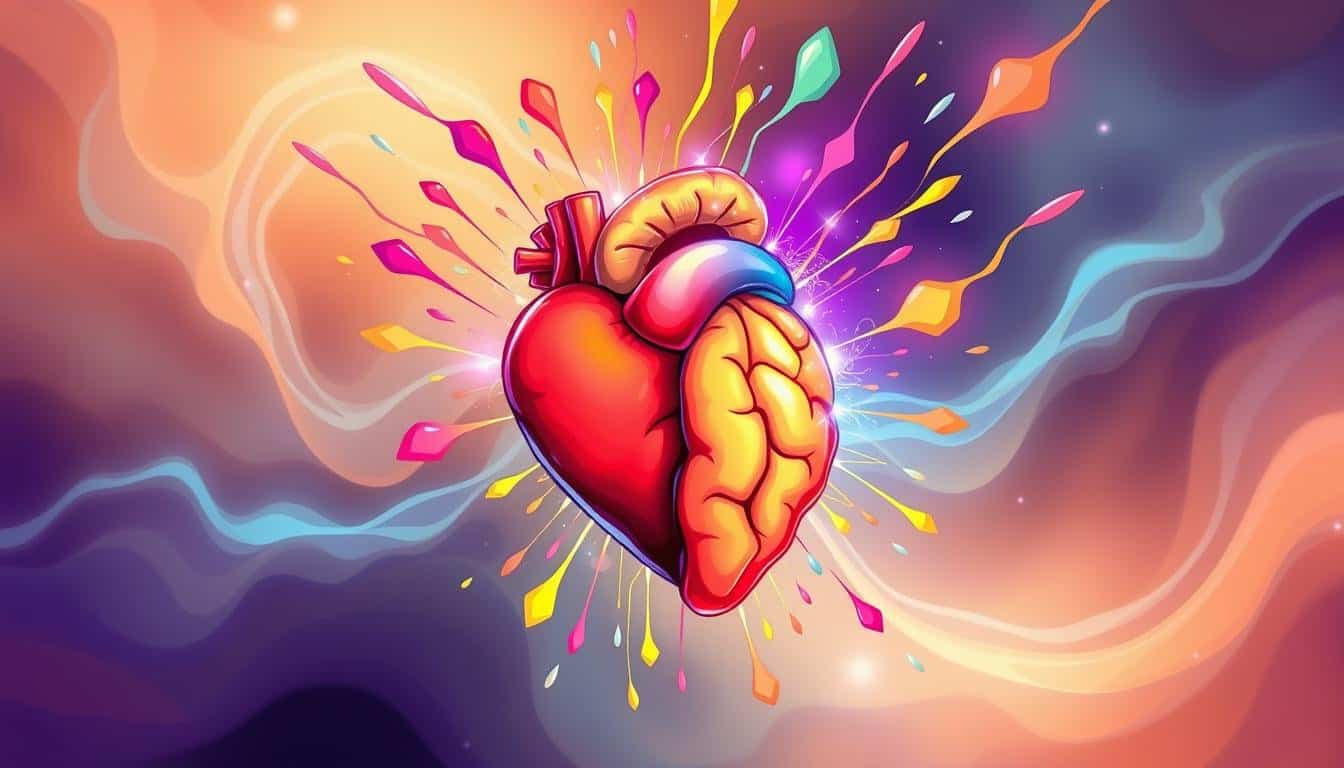Understanding The Cannon-Bard Theory of Emotion
Ever felt fear as your heart raced? The Cannon-Bard Theory of Emotion explains why. Developed in 1927 by Walter Cannon and Philip Bard, it challenges old ideas about emotions and body reactions. It says emotions and physical responses happen at the same time, but they don’t depend on each other.
This theory points to the brain’s thalamus as key in feeling emotions. It changes how we see the link between feeling emotions and physical reactions.
Key Takeaways
- The Cannon-Bard Theory suggests emotions and physiological reactions happen simultaneously.
- The thalamus plays a crucial role in transmitting signals for emotional responses.
- Critiques highlight an overemphasis on the thalamus, neglecting other brain functions.
- Research indicates that physical actions can influence our emotional experiences.
- This theory stands in contrast to the James-Lange Theory, which posits that physiological responses precede emotions.
Introduction to Emotions Theory
Emotions theory blends psychology with how we feel and show feelings. It looks at the complex ways people feel and react. Over time, many frameworks have been created to grasp these emotional responses.
The Cannon-Bard theory from the early 1900s says that feelings and physical changes happen at the same time but are separate. This idea challenges old views on emotions, especially when compared to James-Lange and Schachter-Singer theories.
Studies show the depth of emotional reactions. For example, a study by Havas et al. (2010) found that people with depression felt less depressed when their frowning muscles were frozen with Botox. This study links our body and feelings, supporting emotions theory.
Research by Soussignan (2002) also backs the facial feedback hypothesis. It showed that the intensity of a smile affects our body and feelings. This proves our body’s role in our emotional state.
The Schachter-Singer two-factor theory helps us understand emotions better. It says our feelings come from both our body’s state and what we think. Schachter & Singer (1962) showed that the situation greatly affects how we feel. These theories help us see how complex our emotions are.
| Theory | Key Focus | Founders |
|---|---|---|
| Cannon-Bard Theory | Simultaneous emotional experience and physiological arousal | Walter B. Cannon and Philip Bard |
| James-Lange Theory | Physical response precedes emotional experience | William James and Carl Lange |
| Schachter-Singer Theory | Contextual cognitive appraisal influencing emotion | Stanley Schachter and Jerome Singer |
The Significance of the Cannon-Bard Theory of Emotion
The Cannon-Bard theory is very important in psychology. It gives us a new way to see how we feel emotions. Walter Cannon came up with it in the 1920s, and Philip Bard added to it in the 1930s. They said that emotions and physical reactions happen at the same time.
This idea goes against older theories like the James-Lange theory. That theory said that our body reacts first, then we feel emotions. The Cannon-Bard theory says emotions happen too fast to just be from our body’s reactions. This new view has changed how we study emotions, showing the important role of the thalamus.
Looking closer at the Cannon-Bard theory significance, we see that emotions and physical reactions can start together. This helps us understand better how our brain and feelings work together. It also helps us study how these interactions affect our choices and actions.
Key Components of the Cannon-Bard Theory
The Cannon-Bard theory changed how we see emotions. It shows that emotions and physical reactions happen at the same time. This idea goes against older theories that said they happened one after the other. The theory focuses on the thalamus and how emotions and physical reactions work together.
The Role of the Thalamus
The thalamus is key in the Cannon-Bard theory. It acts as a middleman for sensory info. It sends signals to the amygdala and other brain parts. This quick action lets the brain feel emotions and have physical responses at the same time. It shows how important the thalamus is in handling emotions.
Simultaneous Emotional and Physiological Responses
Cannon and Bard found that emotions and physical reactions happen together. For instance, when someone is scared, they feel fear and their heart races and they sweat. This shows that emotions and physical responses don’t cause each other. It supports the Cannon-Bard theory over older ideas that said one came before the other.
| Aspect | Description |
|---|---|
| Thalamus Role | Processes sensory information and relays signals for simultaneous responses. |
| Emotional Response | Occurs instantly, enabling the feeling of emotions like fear or happiness. |
| Physiological Response | Includes rapid heartbeat, increased blood pressure, and other responses triggered simultaneously. |
| Theory Context | Proposed by Walter Cannon and Philip Bard in the 1920s and 1930s. |
Comparison with Other Theories of Emotion
Exploring emotional theories shows us how different they are. The James-Lange Theory and the Schachter-Singer Theory are two that really stand out. They have their own ways of understanding emotions.
The James-Lange Theory
The James-Lange Theory says that our body reacts first, then we feel emotions. So, if you see something scary, your heart races first, and then you feel fear. This is different from the Cannon-Bard Theory, which says emotions and arousal happen at the same time.
This theory puts more focus on the order of events. It says that how we feel emotions depends a lot on what happens in our body before.
The Schachter-Singer Theory
The Schachter-Singer Theory combines parts of the James-Lange and Cannon-Bard Theories. It says that our body’s arousal is key, but we also need to think about it to know what emotion we’re feeling. This shows how important thinking is in feeling emotions.
It also says that what’s happening around us affects how we see our feelings. This makes the theory very interesting. It shows how our body and mind work together to shape our emotions.
Examples Illustrating the Cannon-Bard Theory
The Cannon-Bard theory shows us how emotions and physical reactions work together in our daily lives. It highlights situations where feelings and body responses happen at the same time.
Common Situations Triggering Emotional Responses
Jobs interviews and first dates are great examples of this theory. When you’re in a job interview, you might feel anxious and notice your hands are sweating and your heart is racing. This shows how emotions and physical reactions happen together, not one after the other.
This tells us that our bodies react quickly to things, without a clear order of events.
The Fight-or-Flight Response in Real Life
The fight-or-flight response is another key part of the Cannon-Bard theory. Imagine you’re facing a wild animal and you feel fear right away, along with a faster heart rate and tense muscles. This shows how emotions and physical changes can happen together, helping us survive.
This highlights the connection between how we feel and how our bodies react, especially in stressful situations.
| Situation | Emotional Response | Physiological Reaction |
|---|---|---|
| Job Interview | Anxiety | Sweaty palms, increased heart rate |
| First Date | Excitement | Butterflies in stomach, flushed cheeks |
| Confronting a Threat | Fear | Rapid heartbeat, heightened alertness |
| Public Speaking | Tension | Shaking hands, shortness of breath |
Applications in Psychological Research
The Cannon-Bard theory greatly impacts psychological research, especially in studying emotions. It says that emotions and body reactions happen at the same time and on their own. This idea helps researchers understand emotions better.
In clinics, the Cannon-Bard theory helps treat stress and anxiety. It shows how emotions and body responses are linked. This knowledge helps therapists create new treatments that meet each person’s needs.
Studies on the thalamus have also moved forward affective neuroscience. This brain part’s role in emotions has led to new ways to study and treat emotional issues. This has brought about new therapies.
Research backs the Cannon-Bard theory, showing we need to look at emotions together to fully understand them. This leads to better ways to help people with mental health issues.
| Research Study | Findings | Applications |
|---|---|---|
| Study by Taylor S.E. et al. (2000) | Introduced the tend-and-befriend response in stress | Informs therapeutic strategies for managing stress in females |
| Research by Ekman P. and Friesen W.V. (1971) | Demonstrated constants in facial expressions across cultures | Assists in cross-cultural emotional assessments |
| Study by Tracy J.L. and Robins R.W. (2008) | Explored nonverbal expressions of pride | Enhances understanding of emotional communication in therapy |
| Research by Frijda N.H. (1988) | Highlighted the laws of emotion | Guides psychological practice in recognizing emotional triggers |
Criticisms of the Cannon-Bard Theory
The Cannon-Bard Theory has faced several criticisms. One main issue is its focus on the thalamus. Critics say it gives the thalamus too much credit in emotions. The thalamus does process sensory info, but it’s not the only part of the brain involved in emotions.
Other areas like the amygdala and cerebral cortex also play a big role. They should be included in any full understanding of emotions.
Overemphasis on the Thalamus
Many experts believe the Cannon-Bard Theory focuses too much on the thalamus. It seems to ignore the complex ways we feel emotions. Studies show emotions come from many parts of the brain, not just the thalamus.
This focus can lead to a simplified view of how emotions work in our brains.
Influence of Physiological Responses on Emotions
Another issue with the Cannon-Bard Theory is its lack of attention to how our body affects our feelings. Research shows that our body’s reactions can actually change how we feel. For example, making a certain face can make us feel the emotion it represents.
This shows that the connection between our body and emotions is stronger than the theory suggests.
| Criticism | Description |
|---|---|
| Thalamus Emphasis | Overemphasis on the thalamus’s role in emotional processing, ignoring contributions of other brain structures. |
| Physiological Influence | Neglects how physiological responses can shape emotional experiences; facial expressions can elicit corresponding emotions. |
| Complexity of Emotions | Oversimplification of emotional processes; fails to account for multiple neural pathways in the emotional experience. |
Insights from Modern Psychological Studies
Modern studies on the Cannon-Bard Theory have deepened our grasp of emotions. They show that emotions and physical responses happen at the same time and on their own. For example, a study by Chwalisz, Diener, and Gallagher (1988) looked at people with spinal cord injuries. They found that even those who couldn’t feel their body’s responses still felt emotions.
This shows that emotions go beyond just feeling physical things. It also shows that knowing about our body’s state can change how intense our emotions are.
Other studies have also shown how our body’s state affects our emotions. Davis, Senghas, and Ochsner (2009) found that hiding our facial expressions can lessen how intense we feel emotions. This shows a strong link between our body’s state and how we feel emotions.
Schachter and Singer (1962) did a study that showed how thinking about a situation can change how we feel. People who got epinephrine shots but didn’t expect them often blamed their feelings on the situation. This shows how our thoughts play a big part in how we feel emotions.
Studies on animals have also helped us understand how our brain and body work together in feeling emotions. New methods like optogenetics let us see how the brain talks to the body. These new ways of studying are helping us learn more about managing our emotions. They’re adding to what we know about emotional intelligence and thinking.
Connection Between Emotions and Human Behavior
Understanding the connection emotions behavior shows how feelings guide our actions. Our feelings shape our choices, how we interact with others, and our mental health. Behavioral psychology says emotions are more than just feelings. They are both physical and mental events that affect everything we do.
Several theories explain this link. The Schachter-Singer Theory says thinking is key to feeling emotions. The Zajonc-LeDoux theory shows some emotions, like those important for survival, can make us react fast without much thought. This shows emotions and actions are complex.
Studies reveal facial expressions are key in showing emotions. Paul Ekman found certain feelings like happiness and fear are recognized worldwide. But, how we show emotions can vary by culture. In America, people tend to show their feelings more openly than in some other cultures.
The Facial Feedback Effect suggests our faces can change how we feel. Smiling can make us feel happier. Also, how people see emotions can be shaped by gender. Women are often seen as better at reading emotions, while men are seen as more likely to show anger.
The Cannon-Bard Theory supports these ideas, saying emotions and body changes happen at the same time. Studies by Chwalisz, Diener, and Gallagher found people with spinal cord injuries felt less intense emotions. This shows the importance of looking at both feelings and body responses in treatment.
Understanding the connection emotions behavior helps us get better at interacting with each other and in therapy. This knowledge lets us create better plans for helping with emotions and behavior.
Conclusion
The Cannon-Bard Theory shows us how emotions and body reactions happen at the same time. Walter Cannon and Philip Bard came up with this idea in the late 1920s. They said that our body’s response to something isn’t just before we feel emotions. Instead, it happens all at once.
This theory is still important today. It helps us see how our thoughts and body reactions work together. By understanding this, psychologists can learn more about how we feel emotions. This helps in making better treatments for stress and mental health.
Even though some people have criticized this theory, it still greatly affects how we study emotions. As we keep learning more, the Cannon-Bard Theory reminds us to look at both our body and mind. This helps us understand ourselves and our feelings better.







